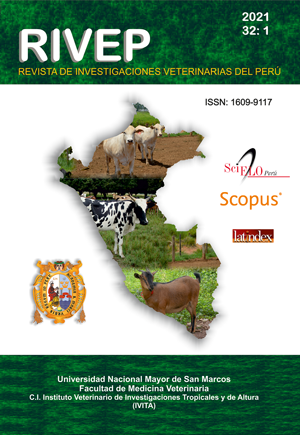Embryo transfer of super ovulated and single ovulated llamas at two periods of the year and under field conditions
DOI:
https://doi.org/10.15381/rivep.v32i1.19511Keywords:
llama, embryo, embryo transfer, ovulationAbstract
Two embryo production protocols were evaluated: superovulation and single ovulation, determining the collection rate and quality of the embryos, as well as fertility and natality during the reproductive and non-reproductive season, at 4200 meters above sea level and under field conditions. The collection rate of embryos in simple ovulation was 53% (44/83) embryos versus 242.3% (63/26) in superovulation. The quality of the embryos collected by single ovulation was: grade I (90.3 and 83.6%) and grade II (9.4 and 16.7%) and none of grade III; while in superovulation it was: grade I (76.6 and 87.5%), grade II (14.9 and 12.5%) and grade III (8.5 and 0%) for the reproductive and non-reproductive seasons, respectively. Fertility was similar between single ovulation (56.4%) and superovulation (56.0%). The birth rate was 41.1 and 30.0% for single ovulation and superovulation, respectively. It is concluded that both techniques represent a feasible alternative for its application in the high Andean llama rearing systems.
Downloads
Downloads
Published
Issue
Section
License
Copyright (c) 2021 Joel Iván Pacheco, Víctor Manuel Vélez, José Manuel Angulo-Tisoc, Wilber García

This work is licensed under a Creative Commons Attribution-NonCommercial-ShareAlike 4.0 International License.
AUTHORS RETAIN THEIR RIGHTS:
a. Authors retain their trade mark rights and patent, and also on any process or procedure described in the article.
b. Authors retain their right to share, copy, distribute, perform and publicly communicate their article (eg, to place their article in an institutional repository or publish it in a book), with an acknowledgment of its initial publication in the Revista de Investigaciones Veterinarias del Perú (RIVEP).
c. Authors retain theirs right to make a subsequent publication of their work, to use the article or any part thereof (eg a compilation of his papers, lecture notes, thesis, or a book), always indicating the source of publication (the originator of the work, journal, volume, number and date).



